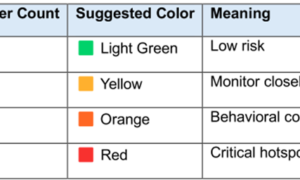Welcome, fellow readers and brand enthusiasts! Today, we delve into a topic that has left us all scratching our heads: why do some brands fail to meet our expectations? We’ve all experienced it—the anticipation of a new product or service that falls flat, leaving us feeling frustrated and disillusioned. In this blog post, we explore those disappointing experiences that can cripple even the most beloved brands and examine how they lose our precious customer loyalty along the way. So fasten your seatbelts as we take you on a journey through the land of missed opportunities and uncover valuable insights on what could have been done better. Get ready to discover how brands miss the mark and ultimately lose out on something money can’t buy: true customer loyalty!
Introduction: What Happens When Brands Miss the Mark?
It’s no secret that customer loyalty is essential to the success of any business. After all, it costs far more to acquire a new customer than it does to keep an existing one. So when brands miss the mark and fail to deliver on their promises, it can have a devastating impact on their bottom line.
There are a number of ways brands can miss the mark with their customers. Sometimes it’s due to a simple mistake, such as failing to properly communicate a change in policy or pricing. Other times, it’s because the brand has strayed from its core values or become too focused on profits instead of its customers. Whatever the reason, the result is always the same: disappointed customers who are less likely to continue doing business with the company.
To avoid disappointing your customers and losing their loyalty, it’s important to always be aware of how your brand is perceived by them. Make sure you’re regularly collecting feedback and using it to improve your products, services, and overall customer experience. By delivering on your promises and exceeding expectations, you’ll earn the loyalty of your customers for years to come.
Common Reasons Why Brands Fall Short of Expectations
There are many reasons why brands fall short of expectations and lose customer loyalty. Some common reasons include:
- failing to live up to promises or meet customer expectations
- failing to deliver on quality or value
- Being too salesy or pushy
- being unresponsive to customer feedback or complaints
- failing to stay relevant or innovate
- Making too many changes too quickly
- being inconsistent in branding or messaging
- Failing to properly train employees on company culture and values
- Allowing employees to act inappropriately or rudely towards customers
Any of these reasons can be enough to cause customers to take their business elsewhere. It’s important for brands to understand what their customers want and need and then deliver on those expectations. Otherwise, they risk losing loyal customers who may never come back.
The Consequences of Disappointing Experiences
When brands disappoint customers, it can have a number of consequences. First, customers may simply take their business elsewhere. This is especially likely if the disappointing experience was due to poor customer service. Second, customers may be less likely to recommend the brand to others. This can damage the brand’s reputation and make it difficult to attract new customers. Third, customers may post negative reviews online, which can further damage the brand’s reputation and make it even harder to attract new customers. Disappointed customers may become disgruntled and seek revenge against the brand, for example by vandalizing property or spreading negative word-of-mouth. This can cause significant financial damage to the brand.
How to Avoid Making Mistakes and Reclaim Customer Loyalty
It’s no secret that poor customer service can lead to a loss of business. In fact, research shows that it takes 12 positive experiences to make up for one negative experience. So, how can you avoid making mistakes and reclaim customer loyalty?
Here are four tips:
1. Listen to your customers.
Make sure you’re really listening to your customers, not just hearing what they’re saying. Pay attention to their body language and tone of voice, as well as the words they’re using. This will give you clues as to how they’re really feeling and what their true needs are.
2. Apologize sincerely.
When you do make a mistake, apologize immediately and sincerely. A simple “I’m sorry” can go a long way toward calming an upset customer and diffusing the situation.
3. Take responsibility and take action.
Own up to your mistakes and take responsibility for them. Then, take action to fix the problem and prevent it from happening again in the future. Your customers will appreciate your transparency and efforts to make things right.
Examples of Companies That Lost Customer Loyalty Due to Poor Experiences
There are many examples of companies that have lost customer loyalty due to poor experiences. One such example is Delta Airlines. In 2017, the airline experienced a major computer outage that resulted in thousands of cancelled or delayed flights. This led to a lot of angry customers and a loss of loyalty for the company. Another example is United Airlines, which had a very public incident in which a passenger was forcibly removed from a flight. This led to widespread negative publicity and a loss of customer loyalty.
How to Increase Brand Awareness and Improve Customer Relationships
If you’re like most businesses, you recognize the importance of customer relationships and brand awareness. After all, happy customers are more likely to buy from you again and recommend your products or services to others. But what happens when your customers have a disappointing experience with your brand? How can you prevent this from happening, and what can you do to improve customer relationships if it does occur?
There are a few key things you can do to increase brand awareness and improve customer relationships:
1. Be responsive to customer feedback.
Make sure you’re regularly monitoring channels like social media and online review sites for mentions of your brand. If customers are unhappy, reach out and try to resolve the issue. If they’re happy, take the opportunity to thank them publicly for their business.
2. Take a proactive approach to customer service.
Don’t wait for customers to come to you with problems; instead, actively reach out on a regular basis (e.g., via email or phone) to check in and see how they’re doing. This will show that you care about their experience with your brand and give you an opportunity to address any issues before they become major problems.
3. Offer loyalty rewards and other incentives.
Recognize and reward customers who frequently do business with you or make referrals. This could be in the form of discounts, exclusive offers, or other perks. Not only will this make those customers feel appreciated, but it will also encourage others to do business with you in the future.
4. Create content that resonates with your target audience.
Content marketing is an important part of increasing brand awareness and improving customer relationships. Not only does it provide valuable information about your products or services, but it also helps to establish trust and credibility in the eyes of potential customers. Make sure you’re creating content that resonates with your target audience and focuses on solving their problems rather than just promoting your product or service.
5. Make use of customer testimonials and reviews.
Social proof is key when it comes to building trust and credibility with potential customers, so make sure you’re leveraging customer testimonials and reviews whenever possible. This can be done through social media posts, third-party review sites, or even on your own website or blog. By showcasing genuine feedback from existing customers, you’ll be able to show potential customers that your brand is trustworthy and reliable.
Conclusion
Disappointing experiences can have a major negative impact on customer loyalty and brand reputation. By understanding how to avoid these pitfalls, companies can create more meaningful relationships with their customers that will help build trust and foster long-term loyalty. Companies should focus on providing exceptional customer service and delivering quality products in order to ensure their customers have positive experiences that encourage them to come back for more. With the right strategies in place, brands can turn disappointing experiences into opportunities for growth while continuing to maintain customer loyalty.



































